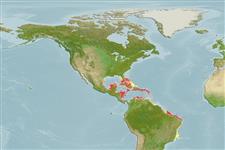Common names from other countries
Environment: milieu / climate zone / depth range / distribution range
Écologie
marin récifal; profondeur 5 - 20 m (Ref. 9710). Tropical
Western Central Atlantic: Florida (USA), Bahamas, Puerto Rico, Grand Cayman Island, Virgin Islands, Antigua, Barbados, Aruba, Curaçao, Colombia, and Venezuela.
Taille / Poids / Âge
Maturity: Lm ? range ? - ? cm
Max length : 8.5 cm TL mâle / non sexé; (Ref. 7251)
Épines dorsales (Total) : 18 - 21; Rayons mous dorsaux (Total) : 31 - 36; Épines anales: 2; Rayons mous anaux: 33 - 37. Light brown with pale dots and a narrow mid-lateral brown stripe, sometimes broken into blotches; faint bars on body; small black spot at front of dorsal fin; mature males with more yellow on head, gill membranes black; branchiostegal rays blue (Ref. 13442).
Occurs in groups, one to a hole, in limestone or coral rubble in clear water. Feeds on small crustaceans, worms, and fishes (Ref. 5521).
Life cycle and mating behavior
Maturities | Reproduction | Spawnings | Egg(s) | Fecundities | Larves
Robins, C.R. and G.C. Ray, 1986. A field guide to Atlantic coast fishes of North America. Houghton Mifflin Company, Boston, U.S.A. 354 p. (Ref. 7251)
Statut dans la liste rouge de l'IUCN (Ref. 130435)
CITES (Ref. 128078)
Not Evaluated
Menace pour l'homme
Harmless
Utilisations par l'homme
Pêcheries: commercial; Aquarium: Commercial
Outils
Articles particuliers
Télécharger en XML
Sources Internet
Estimates based on models
Preferred temperature (Ref.
115969): 26.4 - 28.2, mean 27.5 (based on 520 cells).
Phylogenetic diversity index (Ref.
82804): PD
50 = 0.5010 [Uniqueness, from 0.5 = low to 2.0 = high].
Bayesian length-weight: a=0.00457 (0.00183 - 0.01143), b=3.08 (2.86 - 3.30), in cm Total Length, based on LWR estimates for this (Sub)family-body shape (Ref.
93245).
Niveau trophique (Ref.
69278): 3.7 ±0.55 se; based on food items.
Fishing Vulnerability (Ref.
59153): Low vulnerability (10 of 100).
